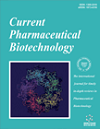- Home
- A-Z Publications
- Current Pharmaceutical Biotechnology
- Previous Issues
- Volume 13, Issue 1, 2012
Current Pharmaceutical Biotechnology - Volume 13, Issue 1, 2012
Volume 13, Issue 1, 2012
-
-
Biological Activity of Carotenoids: Its Implications in Cancer Risk and Prevention
More LessAuthors: Mary Chatterjee, Kaushik Roy, M. Janarthan, Subhadeep Das and Malay ChatterjeeRecently nontoxic natural compounds are getting immense importance for the prevention of diseases of different etiology. Natural product provitamin A “carotenoids”, largely α-carotene, β-carotene, and β-cryptoxanthin, are typical constituents of orange/red/yellow colored fruits and green vegetables. Different in vitro and in vivo studies have shown that carotenoids possess the capacity to scavenge DNA damaging fre Read More
-
-
-
The Chemopreventive and Chemotherapeutic Potentials of Tea Polyphenols
More LessAuthors: Vijay S. Thakur, Karishma Gupta and Sanjay GuptaTea is the second most consumed beverage in the world reported to have multiple health benefits. Preventive and therapeutic benefits of tea polyphenols include enhanced general well being and anti-neoplastic effects. The pharmacologic action of tea is often attributed to various catechins present therein. Experiments conducted in cancer cell lines and animal models demonstrate that tea polyphenols protect agai Read More
-
-
-
Mechanisms Underlying the Anti-Proliferative Effects of Berry Components in In Vitro Models of Colon Cancer
More LessAuthors: Emma M. Brown, Chris I.R. Gill, Gordon J. McDougall and Derek StewartConsumption of fruit and vegetables is associated with a decreased risk of several cancers, particularly colorectal cancer, possibly linked to their phytochemical content, which is of interest due to several proposed health benefits, including potential anticancer activity. Epidemiological data suggests that cancers of the digestive tract are most susceptible to dietary modification, possibly due to being in direct contact with bioa Read More
-
-
-
Silymarin in the Prevention and Treatment of Liver Diseases and Primary Liver Cancer
More LessAuthors: Janos Feher and Gabriella LengyelIn chronic liver diseases caused by oxidative stress (alcoholic and non-alcoholic fatty liver diseases, drug- and chemical-induced hepatic toxicity), the antioxidant medicines such as silymarin can have beneficial effect. Liver cirrhosis, non-alcoholic fatty liver and steatohepatitis are risk factors for hepatocellular carcinoma (HCC). Insulin resistance and oxidative stress are the major pathogenetic mechanisms leading the hepatic Read More
-
-
-
Curcumin and Liver Cancer: A Review
More LessAuthors: Altaf S. Darvesh, Bharat B. Aggarwal and Anupam BishayeePrimary liver cancer, also known as hepatocellular carcinoma (HCC), is one of the most lethal cancers having worldwide prevalence. Although most HCC cases are reported in the developing countries of Asia and Africa, there has been an alarming increase in HCC cases in Western Europe as well as United States. Chronic liver diseases, viral hepatitis, alcoholism as well as dietary carcinogens, such as aflatoxins and nitrosoamines, Read More
-
-
-
Alteration of Hepatic Proinflammatory Cytokines is Involved in the Resveratrol-Mediated Chemoprevention of Chemically-Induced Hepatocarcinogenesis
More LessHepatocellular carcinoma (HCC), one of the most common cancers in the world, is a leading cause of cancerrelated mortality. HCC develops most frequently in the background of oxidative stress and chronic hepatic inflammation due to viral infections, alcohol abuse as well as exposure to environmental and dietary carcinogens. As the prognosis of HCC is extremely poor and mostly unresponsive to current chemotherapeuti Read More
-
-
-
Current Status on Natural Products with Antitumor Activity from Brazilian Marine Sponges
More LessOver the last few years, samples from the marine environment have been screened for a variety of compounds with different biological activities. Among all marine organisms, sponges represent one of the most promising sources of leads in the research of new cancer drugs. However, there are few reports on screening Brazilian marine sponges for biological activities. In the following review, the current status of natural prod Read More
-
-
-
Targeting the Wingless Signaling Pathway with Natural Compounds as Chemopreventive or Chemotherapeutic Agents
More LessAuthors: Marie-Helene Teiten, Francois Gaascht, Mario Dicato and Marc DiederichThe aberrant activation of the wingless (Wnt) signaling pathway is a key element involved in carcinogenesis as Wnt regulates a variety of cellular processes including proliferation, differentiation, survival, apoptosis and cell motility. Upon Wnt receptor activation, the canonical “Wnt/beta-catenin” as well as the non canonical “Wnt/planar cell polarity, Wnt/Ca2+” pathways are activated. This offers multiple possibilities to tar Read More
-
-
-
Genomics-Based Identification of Molecular Mechanisms behind the Cancer Preventive Action of Phytochemicals: Potential and Challenges
More LessAuthors: Theo M.C.M. de Kok, Simone G.J. van Breda and Jacob J. BriedeHigh intake of dietary phytochemicals, non-nutritive compounds found in vegetables and fruits, has been associated with a decreased risk of various types of cancer. With the introduction of new “omics” research approaches, technologies providing large scale and holistic data on biological responses to dietary or environmental factors, our understanding of the molecular mechanisms of the preventive action of ind Read More
-
-
-
Biotechnologically Produced Secondary Plant Metabolites for Cancer Treatment and Prevention
More LessAuthors: Liudmila Korkina and Vladimir KostyukSecondary metabolites of higher plants exert numerous effects on tumorigenesis, on tumor cells in vitro, tumors in experimental animals in vivo, interact with anti-cancer drugs, thus affecting positively or negatively their efficacy, and protect normal tissues of the host organism against adverse effects of anti-cancer therapies. The industrial development of pharmaceutical and nutraceutical products based on secondary Read More
-
Volumes & issues
-
Volume 26 (2025)
-
Volume 25 (2024)
-
Volume 24 (2023)
-
Volume 23 (2022)
-
Volume 22 (2021)
-
Volume 21 (2020)
-
Volume 20 (2019)
-
Volume 19 (2018)
-
Volume 18 (2017)
-
Volume 17 (2016)
-
Volume 16 (2015)
-
Volume 15 (2014)
-
Volume 14 (2013)
-
Volume 13 (2012)
-
Volume 12 (2011)
-
Volume 11 (2010)
-
Volume 10 (2009)
-
Volume 9 (2008)
-
Volume 8 (2007)
-
Volume 7 (2006)
-
Volume 6 (2005)
-
Volume 5 (2004)
-
Volume 4 (2003)
-
Volume 3 (2002)
-
Volume 2 (2001)
-
Volume 1 (2000)
Most Read This Month
Article
content/journals/cpb
Journal
10
5
false
en


